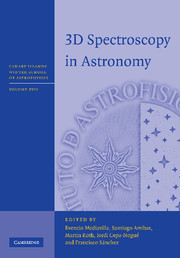Book contents
- Frontmatter
- Contents
- List of contributors
- List of participants
- Preface
- Acknowledgements
- List of abbreviations
- 1 Introductory review and technical approaches
- 2 Observational procedures and data reduction
- 3 3D spectroscopic instrumentation
- 4 Analysis of 3D data
- 5 Science motivation for integral field spectroscopy and Galactic studies
- 6 Extragalactic studies and future integral field spectroscopy science
- 7 Tutorials: How to handle 3D spectroscopy data
5 - Science motivation for integral field spectroscopy and Galactic studies
Published online by Cambridge University Press: 06 August 2010
- Frontmatter
- Contents
- List of contributors
- List of participants
- Preface
- Acknowledgements
- List of abbreviations
- 1 Introductory review and technical approaches
- 2 Observational procedures and data reduction
- 3 3D spectroscopic instrumentation
- 4 Analysis of 3D data
- 5 Science motivation for integral field spectroscopy and Galactic studies
- 6 Extragalactic studies and future integral field spectroscopy science
- 7 Tutorials: How to handle 3D spectroscopy data
Summary
This lecture introduces the scientific motivation for integral field spectroscopy (IFS) and describes the results from this novel technique in Galactic studies as of 2005. The following chapter by Luis Colina then picks up on extragalactic studies and rounds out the picture giving an outlook to future integral field spectroscopic studies. Following the five one-hour lectures, this chapter is broken down into sections on:
science motivation;
the Galactic Centre black hole;
the Galactic Centre stellar population;
star formation; and
the Solar System.
The publications discussed in this lecture are selected on the basis of their scientific impact as measured by the citation index and/or because they specifically qualify for a lecture from a didactic point of view.
Science motivation
Motivation for the development and application of integral field spectroscopy is manifold and is closely tied to personal interest and background. This is most obvious in the history of instrument development, outlined in the beginning of this section. The ‘ideal’ objects for integral field observations can be well characterized by their angular size, substructure and spectral characteristics. These qualifiers are used to identify the ideal objects on the distance ladder. The section ends comparing the apparent interest of the Galactic and extragalactic astronomical communities in integral field spectroscopy.
Motivation for integral field spectroscopy
The development of the first-generation integral field spectrographs was largely driven by an ‘experimental’ motivation.
- Type
- Chapter
- Information
- 3D Spectroscopy in Astronomy , pp. 158 - 199Publisher: Cambridge University PressPrint publication year: 2010

